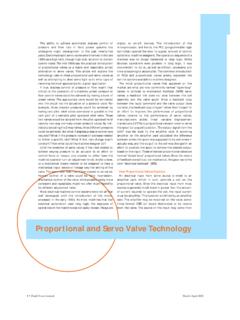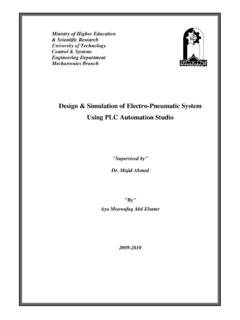Transcription of Steering Control Units Steering Catalog Steering ... - Eaton
1 Steering CatalogSteering Control UnitsTorque GeneratorsSteering ColumnsEATON Steering Catalog C-STOV-MC001-E3 November 20212 Literature Referenced in this Catalog : Eaton Technical Bulletin 3-401 Eaton Flow Divider Catalog E-VLFL-MC001-E Eaton Relief Valve Catalog 11-510 Eaton Gear Pumps Series 26 Model 26000 Catalog 11-609 Eaton Char-Lynn Low Speed High Torque Motors Catalog E-MOLO-MC001-E2 Vickers Screw in Cartridge Values Catalog V-VLOV-MC001-E2 Vickers Proportional valves Catalog 539 Vickers Solenoid operated directional valves Catalog GB-C-2015 Eaton Steering Catalog C-STOV-MC001-E3 November 20213 Description and AdvantagesSteering Control UnitsThe Char-Lynn Steering Control unit (SCU) is fully fluid linked. This means there is no mechanical connection between the Steering unit, the pump and the Steering cylinders. The unit consists of a manually operated directional Control servo valve and feedback meter element in a single body. It is used principally for fluid linked power Steering systems but it can be used for some servo-type applications or any application where visual positioning is required.
2 The close coupled, rotary action valve performs all necessary fluid directing functions with a small number of moving parts. The manually actuated valve is coupled with the mechanical drive to the meter gear. The Control is lubricated and protected by the power fluid in the system and can operate in many power Steering Control Units offer the following advantages: Minimizes Steering linkage reduces cost, provides flex-ibility in design. Provides complete isolation of load forces from the con-trol station provides operator comfort. Provides continuous, unlimited Control action with very low input torque. Provides a wide selection of Control circuits and meter sizes. Can work with many kinds of power Steering pumps or fluid supply.* For all other product numbers consult Steering 5 (291-XXXX-XXX, 292-XXXX-XXX, 293-XXXX-XXX, 294-XXXX-XXX) Displacement - 146 cm3/r - in3/rFlow 11 - 19 l/min 3 - 5 GPMP ressure 140 bar 2030 PSISERIES 25 (251-XXXX-XXX, 252-XXXX-XXX, 253-XXXX-XXX)Displacement 490 - 1230 cm3/r 30 - 75 in3/rFlow 95 - 151 l/min 25 - 40 GPMP ressure 241 bar 3500 PSISERIES 40 (281-XXXX-XXX, 282-XXXX-XXX, 283-XXXX-XXX)*Displacement 1230 - 3030 cm3/r 75 - 185 in3/rFlow 151 - 227 l/min 40 - 60 GPMP ressure 241 bar 3500 PSIEATON Steering Catalog C-STOV-MC001-E3 November 20214 Description and AdvantagesTorque GeneratorChar-Lynn torque generators have been completely rede-signed to meet the needs of the changing marketplace.
3 These torque generators have served the industry well, providing: Power assist for vehicle Steering Power assist on gates and valves , eliminating the large hand wheels Powerful rotary motion with effortless manual rotary input on numerous other applicationsToday s market includes power Steering on electric lift trucks. These new torque generators have been designed with fea-tures that greatly improve the operator s comfort as well as the vehicle s the Torque Generator as rotary power assist for: Large indexing tables Manually operated gates and valves Manual positioning devices Mechanical Steering systems TurntablesCustomized Steering ColumnsChar-Lynn columns can be custom built to your exact specifi-cations. The column and mounting flange is of a sturdy single weldment design. These columns have high thrust and side load capacity with low shaft torsional friction. A tilt column is also 217, 227 Displacement 76 - 160 cm3/r - in3/rFlow 15 l/min 4 GPMP ressure 69 and 172 bar 1000 and 2500 PSISTEERING COLUMNS (204-XXXX-XXX)Jacket Length 56 - 836 mm - 33 inchHorn Wire with and without with and withoutUpper Ends 10 Upper End Types 10 Upper End TypesEATON Steering Catalog C-STOV-MC001-E3 November 20215 Hydraulic Circuit ExplanationNeutral Circuits: Open Center and Open Center Power BeyondOpen Center Simplest, most economical system Uses a fixed displacement pump In neutral position pump and tank are connected Most suitable on smaller type vehiclesOpen Center Power BeyondThe power beyond Steering Control unit supplies Steering and auxiliary valve functions.
4 The power beyond unit is used on medium pressure, open center (fixed displacement pump) systems. When not Steering , the power beyond unit directs all inlet flow to the auxiliary circuit. However once Steering is initiated, part of the auxiliary flow is diverted to Steering . Since Steering has priority, all flow, if required, will be di-verted to Steering . The tank port of the Steering unit has flow only when Steering is operated . Thus, flow out of the auxiliary ( PB ) port and the tank port will fluctuate or stop depending on Steering following special considerations should be addressed when applying power beyond Steering : Auxiliary valves (connected to PB) must be open center type. Slight bump or kick may be felt in Steering wheel when auxiliary functions are activated during Steering operations. Pump flow not used for Steering is available at power beyond (PB) outlet, except at Steering stops where total pump flow goes over the system relief valve. Avoid auxil-iary functions that require constant flow while Steering .
5 Flow is only directed to the tank port when Steering is operated . Avoid systems where return flow from tank port is used for auxiliary functions. Inlet pressure to the Steering unit will be the higher of Steering system pressure or auxiliary valve pressure. Generally avoid systems where heavy use of auxiliary functions occur while Lawn and Garden Equipment Utility VehiclesTFixedDisplacementPumpGerotorGer otorLRLRPBPPTF ixedDisplacementPumpTo Auxilliary CircuitOpen Center ValvesEATON Steering Catalog C-STOV-MC001-E3 November 20216 Hydraulic Circuit ExplanationNeutral Circuits: Closed CenterClosed Center Uses a pressure compensated variable displacement pump In neutral position pump and tank are disconnected Most suitable on large construction equipmentClosed Center with Neutral BleedNeutral Bleed FeatureClosed Center Steering Control Units are available with and without neutral bleed feature. Most applications may not re-quire the bleed feature, however, the maximum temperature differential between components within the Steering circuit must not exceed specification (50 F or 28 C).
6 Order unit with the bleed feature if the temperature differential may ex-ceed this limit. The neutral bleed feature allows a small flow of fluid to pass through the unit when in neutral to reduce the thermal applications where neutral bleed is required are: Remote Steering position from power source. Extended engine idle operation when vehicle is parked. High duty cycle operation sharing a common reservoir with the Steering Construction IndustryValve Option AClosed CenterSystemPressureCompensatedPumpPRLTP RLTD irectMechanicalLinkSteeringControlUnitGe rotorMeteringMechanismwithNeutralBleedEA TON Steering Catalog C-STOV-MC001-E3 November 20217 Hydraulic Circuit ExplanationNeutral Circuits: Load SensingLoad Sensing CircuitsChar-Lynn load sensing power Steering uses conventional or load sensing power supplies to achieve load sensing Steering . The use of a load sensing Steering unit and a priority valve in a normal power Steering circuit offers the following advantages: Provides smooth pressure compensated Steering be-cause load variations in the Steering circuit do not affect axle response or maximum Steering rate.
7 Provides true power beyond system capability by splitting the system into two independent circuits. Pressure tran-sients are isolated in each circuit. Only the flow required by the Steering maneuver goes to the Steering circuit. Flow not required for Steering is available for use in the auxiliary circuits. Provides reliable operation because the Steering circuit always has flow and pressure load sensing Steering Control Units and priority valves can be used with open center, closed center or load sensing systems. Use in an open center system with a fixed displacement pump or a closed center system with a pres-sure compensated pump, offers many of the features of a load sensing system. Excess flow is available for auxiliary circuitsListed below are the components of a typical load sensing Control circuit and a brief application May be fixed displacement, pressure compensated, or flow and pressure compensated Valve Sized for design pressure drop at maximum pump output flow rate and priority flow requirements.
8 The minimum Control pressure must assure adequate Steering flow rate and must be matched with the Steering Control unit. A dynamic signal priority valve must be used with a dynamic signal Steering Control Control Unit Designed for specific rated flows and Control pressures. It must be matched with a Control pressure in the priority valve to obtain maximum Steering rates. Higher flow rates require higher Control pressures. Neu-tral internal bleed assures component temperature Line A LS line is always needed to sense pressure downstream from the variable Control orifice in the Steering Control unit. This is balanced by an internal passage to the opposite side of the priority Control spool. The total system performance depends on careful consideration of the Control pressure chosen and pressure drop in the CF Relief Valve Must be factory set at least 10 bar [145 PSl] above the maximum Steering cylinder pressure requirement. Most of the flow will be directed to the auxiliary circuit (EF) when the relief setting is Main Relief Valve A pressure relief valve for the auxiliary circuit and/or a main safety valve for the protection of the pump is recommended and sized for the maximum pump output flow rate.
9 If a main relief valve is used, it must be set above the priority circuit Steering relief valve pressure Load SensingDS Dynamic SignalPP Pilot PressureCF Control FlowEF Excess FlowFilterPumpPrime MoverMainReliefManualInputSteering CylinderLoadSensingSteering UnitTLSTPLRP riority ValveHigh PressureCarryoverPCFEFDSLSPPD ynamicSignalEATON Steering Catalog C-STOV-MC001-E3 November 20218 Hydraulic Circuit ExplanationNeutral Circuits: Load SensingLoad Sensing Circuits Signal SystemsTwo types of load sensing signal systems are available Dynamic and Signal Used for more difficult applications. The dynamic signal systems offer the following benefits: Faster Steering response. Improved cold weather start-up performance. Increased flexibility to solve problems related to system performance and Signal Open Center PumpDynamic Signal Load Sensing PumpTLSPLSCFEFRLPTHigh PressureCarryover to Auxiliary Circuit withOpen Center Valve(s)Fixed Displacement PumpLoadSensingSteeringSystem with Fixed Displacement Pump (Open Center Circuit)LoadSensing(DynamicSignal)Steeri ngControl Unit(non-loadreaction)Priority Valve(DynamicSignal)DynamicSignalTLSPLSC FEFRLTPA uxiliaryCircuit withLoad Sensing Valve(s)Pilot Signalfrom AuxiliaryCircuitPressure and FlowCompensated PumpShuttle ValveLoad Sensing Steering System with Pressure and Flow Compensated Pump (ClosedCenter, Load Sensing Circuit)LoadSensing(DynamicSignal)Steeri ngControl Unit(non-loadreaction)Priority Valve(Dynamic Signal)DynamicSignalEATON Steering Catalog C-STOV-MC001-E3 November 20219 Hydraulic Circuit ExplanationNeutral Circuits.
10 Load SensingStatic Signal Open Center PumpStatic Signal Used for conventional applications where response or circuit stability is not a problem. The load sensing pilot line should not exceed 2 meters [6 feet] in withOpen CenterValve(s)Fixed Displacement PumpLoadSensingSteeringSystem withFixed Displacement Pump(Open Center Circuit)LoadSensing(StaticSignal)Steerin gControl Unit(non-loadreaction)Priority Valve(StaticSignal)Static SignalEATON Steering Catalog C-STOV-MC001-E3 November 202110 Hydraulic Circuit ExplanationWork Circuits: Non-Load Reaction and Load ReactionNon-Load ReactionA non-load reaction Steering unit blocks the cylinder ports in neutral, holding the axle position whenever the operator releases the Steering ReactionA load reaction Steering unit couples the cylinder ports internally (in the neutral position) with the meter gear set. Axle forces are then allowed to return the Steering wheel to its approximate original position. Comparable to automobile Steering , gradually releasing the wheel mid turn will allow the Steering wheel to spin back as the vehicle cylinder system used with load reaction Units must have equal oil volume displaced in both directions.














